Characterization of Foot-and-Mouth Disease Viruses in Zambia-Implications for the Epidemiology of the Disease in Southern Africa
Abstract
:1. Introduction
2. Materials and Methods
2.1. Study Area
2.2. Sample Collection
2.3. Laboratory Analysis of Samples
3. Results
3.1. Epidemiology and Clinical Observations
3.2. Phylogenetic Analyses
4. Discussion
5. Conclusions
Author Contributions
Funding
Institutional Review Board Statement
Data Availability Statement
Acknowledgments
Conflicts of Interest
References
- Alexandersen, S.; Zhang, Z.; Donaldson, A.I.; Garland, A.J.M.; Alexandersen, S.; Zhang, Z.; Donaldson, A.I.; Garland, A.J.M. The pathogenesis and diagnosis of Foot-and-Mouth Disease. J. Comp. Pathol. 2003, 129, 1–36. [Google Scholar] [CrossRef]
- Sangula, A.K.; Belsham, G.J.; Muwanika, V.B.; Heller, R.; Balinda, S.N.; Siegismund, H.R. Co-circulation of two extremely divergent serotype SAT 2 lineages in Kenya highlights challenges to Foot-and-Mouth Disease control. Arch. Virol. 2010, 155, 1625–1630. [Google Scholar] [CrossRef]
- Thomson, G.R.; Bastos, A.D.S. Viral Disease Picornaviridae—Foot-and-Mouth Disease: Section 4; Oxford University Press Southern Africa: Cape Town, South Africa, 2004. [Google Scholar]
- Weaver, G.V.; Domenech, J.; Thiermann, A.R.; Karesh, W.B. Foot and Mouth Disease: A look from the wild side. J. Wildl. Dis. 2013, 49, 759–785. [Google Scholar] [CrossRef] [PubMed]
- Knowles, N.J.; Samuel, A.R. Molecular epidemiology of Foot-and-Mouth Disease virus. Virus Res. 2003, 91, 65–80. [Google Scholar] [CrossRef]
- Freimanis, G.; Di Nardo, A.; Bankowska, K.; King, D.; Wadsworth, J.; Knowles, N.; King, D. Genomics and outbreaks: Foot and Mouth Disease. Rev. Sci. Tech. 2016, 35, 175–189. [Google Scholar] [CrossRef] [PubMed] [Green Version]
- Paton, D.J.; Sumption, K.J.; Charleston, B. Options for control of foot-and-mouth disease: Knowledge, capability and policy. Philos. Trans. R. Soc. B Biol. Sci. 2009, 364, 2657–2667. [Google Scholar] [CrossRef] [PubMed]
- Kasanga, C.J.; Wadsworth, J.; Mpelumbe-Ngeleja, C.A.; Sallu, R.; Kivaria, F.; Wambura, P.N.; Yongolo, M.G.; Rweyemamu, M.M.; Knowles, N.J.; King, D.P. Molecular Characterization of Foot-and-Mouth Disease Viruses Collected in Tanzania between 1967 and 2009. Transbound. Emerg. Dis. 2015, 62, e19–e29. [Google Scholar] [CrossRef] [PubMed]
- Overby, E.; Zyambo, G.C.N. Foot and Mouth Disease outbreaks in Zambia. Rev. Sci. Tech. Off. Int. Epizotics 1983, 2, 189–197. [Google Scholar] [CrossRef] [PubMed] [Green Version]
- Rweyemamu, M.; Roeder, P.; Mackay, D.; Sumption, K.; Brownlie, J.; Leforban, Y.; Valarcher, J.F.; Knowles, N.J.; Saraiva, V. Epidemiological patterns of Foot-and-Mouth Disease worldwide. Transbound. Emerg. Dis. 2008, 55, 57–72. [Google Scholar] [CrossRef] [PubMed]
- Paton, D.J.; Valarcher, J.F.; Bergmann, I.; Matlho, O.G.; Zakharov, V.M.; Palma, E.L.; Thomson, G.R. Selection of Foot and Mouth Disease vaccine strains—A review. Rev. Sci. Tech. Off. Int. Epizotics 2005, 24, 981–993. [Google Scholar] [CrossRef]
- Maree, F.F.; Kasanga, C.J.; Scott, K.A.; Opperman, P.A.; Melanie, C.; Sangula, A.K.; Raphael, S.; Yona, S.; Wambura, P.N.; King, D.P.; et al. Challenges and prospects for the control of foot-and-mouth disease: An African perspective. Vet. Med. 2014, 5, 119–138. [Google Scholar]
- Anonymous. Sixth National Development Plan for Zambia 2011 to 2015; Ministry of Finance and National Planning: Lusaka, Zambia, 2011.
- Perry, B.D.; Hedger, R.S. History and epidemiology of foot-and-mouth disease in Zambia: A review. Trop. Anim. Health Prod. 1984, 16, 107–114. [Google Scholar] [CrossRef]
- Sinkala, Y.; Simuunza, M.; Pfeiffer, D.U.; Munang'andu, H.M.; Mulumba, M.; Kasanga, C.J.; Muma, J.B.; Mweene, A.S. Challenges and Economic Implications in the Control of Foot and Mouth Disease in Sub-Saharan Africa: Lessons from the Zambian Experience. Vet. Med. Int. 2014, 2014, 373921. [Google Scholar] [CrossRef] [Green Version]
- Morris, J.P.A. Annual Report for the Department of Veterinary Services for the Year 1933; Government of Northern Rhodesia: Lusaka, Zambia, 1934; p. 71.
- Chilonda, P.; Woodford, J.D.; Ahmadu, B.; Samui, K.L.; Syakalima, M.; Mlangwa, J.E. Foot and mouth disease in Zambia: A review of the aetiology and epidemiology and recommendations for possible control. Rev. Sci. Tech. Off. Int. Epizotics 1999, 18, 585–592. [Google Scholar] [CrossRef] [PubMed]
- Thobokwe, G.; Matlho, O.; Fana, E.; Dibe, S. Resurgence of Foot and Mouth Disease in the Southern Africa Development Community (SADC) Region. In Proceedings of the 9th Annual Congress of the Southern African Society for Veterinary Epidemiology and Preventive Medicine, Farm Inn, Pretoria, South Africa, 18–20 August 2010. [Google Scholar]
- Thomson, G.; Penrith, M.-L.; Fosgate, G. Technical challenges associated with the eradication of TADs in Southern Africa with special reference to FMD. In Proceedings of the Joint SADC/AHEAD Workshop: Reconcilling Livestock Health and Wildlife Conservation goals in Southern Africa: Strategies for Sustainable Economic Development, Phakalane Golf Estates, Gaborone, Botswana, 13–16 November 2012. [Google Scholar]
- Thomson, G. Foot and Mouth Disease from a Southern African perspective. In Proceedings of the Foot and Mouth Disease Prevention and Control from a Global, SADC and Southern African Perspective and Experience, Pretoria, South Africa, 23 September 2020. [Google Scholar]
- Hamoonga, R.; Stevenson, M.A.; Allepuz, A.; Carpenter, T.E.; Sinkala, Y. Risk factors for foot-and-mouth disease in Zambia, 1981–2012. Prev. Vet. Med. 2014, 114, 64–71. [Google Scholar] [CrossRef] [PubMed]
- Sinkala, Y. Epidemiology of Foot and Mouth Disease in Zambia. Ph.D. Thesis, The University of Zambia, Lusaka, Zambia, 2015. [Google Scholar]
- Kitching, R.; Donaldson, A. Collection and transportation of specimens for vesicular virus investigation. Rev. Sci. Tech. Off. Int. Epizotics 1987, 6, 263–272. [Google Scholar]
- World Organization for Animal Health. OIE Chapter 8.6: Foot and Mouth Disease: Article 8.6.1. Available online: http://www.oie.int/index.php?id=169&L=0&htmfile=chapitre_1.8.6.htm (accessed on 13 May 2014).
- Snowdon, W.A. Growth of Foot-and Mouth Disease virus in monolayer cultures of calf thyroid cells. Nature 1966, 210, 1079–1080. [Google Scholar] [CrossRef] [PubMed]
- De Castro, M. Behaviour of the Foot-and-Mouth Disease virus in cell cultures: Susceptibility of the IB-RS-2 cell line. Arq. Inst. Biol. 1964, 31, 63–78. [Google Scholar]
- Ferris, N.P.; Dawson, M. Routine application of enzyme-linked immunosorbent assay in comparison with complement fixation for the diagnosis of Foot-and-Mouth and Swine Vesicular Diseases. Vet. Microbiol. 1988, 16, 201–209. [Google Scholar] [CrossRef]
- Roeder, P.L.; Le Blanc Smith, P.M. Detection and typing of foot-and-mouth disease virus by enzyme-linked immunosorbent assay: A sensitive, rapid and reliable technique for primary diagnosis. Res. Vet. Sci. 1987, 43, 225–232. [Google Scholar] [CrossRef]
- Callahan, J.D.; Brown, F.; Csorio, F.A.; Sur, J.H.; Kramer, E.; Long, G.W.; Lubroth, J.; Ellis, S.J.; Shoulars, K.S.; Gaffney, K.L.; et al. Use of a portable real-time reverse transcriptase-polymerase chain reaction assay for rapid detection of Foot-and-Mouth Disease virus. J. Am. Vet. Med. Assoc. 2002, 220, 1636–1642. [Google Scholar] [CrossRef] [PubMed]
- Shaw, A.E.; Reid, S.M.; Ebert, K.; Hutchings, G.H.; Ferris, N.P.; King, D.P. Implementation of a one-step real-time RT-PCR protocol for diagnosis of foot-and-mouth disease. J. Virol. Methods 2007, 143, 81–85. [Google Scholar] [CrossRef] [PubMed]
- Knowles, N.J.; Wadsworth, J.; Bachanek-Bankowska, K.; King, D. VP1 sequencing protocol for foot and mouth disease virus molecular epidemiology. Rev. Sci. Tech. Off. Int. Epizotics 2016, 35, 741–755. [Google Scholar] [CrossRef] [PubMed] [Green Version]
- Thompson, J.D.; Higgins, D.G.; Gibson, T.J. CLUSTAL W: Improving the sensitivity of progressive multiple sequence alignment through sequence weighting, position-specific gap penalties and weight matrix choice. Nucleic Acids Res. 1994, 22, 4673–4680. [Google Scholar] [CrossRef] [Green Version]
- Hall, T.A. BioEdit: A user-friendly biological sequence alignment editor and analysis program for Windows 95/98/NT. Nucleic Acids Symp. Ser. 1999, 41, 95–98. [Google Scholar]
- Kumar, S.; Stecher, G.; Tamura, K. MEGA7: Molecular Evolutionary Genetics Analysis Version 7.0 for Bigger Datasets. Mol. Biol. Evol. 2016, 33, 1870–1874. [Google Scholar] [CrossRef] [PubMed] [Green Version]
- Anonymous. Annual Report 2016; Government of Zambia, Ministry Agriculture and Livestock Department of Veterinary: Lusaka, Zambia, 2017.
- Banda, F. Provincial Veterinary Officer; Department of Veterinary Services: Mongu, Western Province, Zambia, 2016. [Google Scholar]
- Thomson, G.R.; Penrith, M.L.; Atkinson, M.W.; Atkinson, S.J.; Cassidy, D.; Osofky, S.A. Balancing livestock production and wildlife conservation in and around Southern Africa's transfrontier conservation areas. Transbound. Emerg. Dis. 2013, 60, 492–506. [Google Scholar] [CrossRef] [PubMed]
- Mweene, A.S.; Pandey, G.S.; Sinyangwe, P.; Nambota, A.; Samui, K.; Kida, H. Viral diseases of livestock in Zambia. Jpn. J. Vet. Res. 1996, 44, 89–105. [Google Scholar] [PubMed]
- Mulenga, F. Chief Veterinary Officer; Department of Veterinary Services, Ministry of Fisheries and Livestock: Lusaka, Zambia, 2019.
- Mumba, C.; Häsler, B.; Muma, J.B.; Munyeme, M.; Sitali, D.C.; Skjerve, E.; Rich, K.M. Practices of traditional beef farmers in their production and marketing of cattle in Zambia. Trop. Anim. Health Prod. 2018, 50, 49–62. [Google Scholar] [CrossRef] [PubMed] [Green Version]
- Muuka, G.; Songolo, N.; Kabilika, S.; Hang’ombe, B.M.; Nalubamba, K.S.; Muma, J.B. Challenges of controlling contagious bovine pleuropneumonia in sub-Saharan Africa: A Zambian perspective. Trop. Anim. Health Prod. 2012, 45, 9–15. [Google Scholar] [CrossRef] [PubMed]
- Lubinga, J. Foot and Mouth Disease Outbreak Report—Eastern Province, Lundazi District; Department of Veterinary Office, Office of the Provincial Veterinary Officer: Chipata, Zambia, 22 May 2000.
- Siankuku, N. Livestock Officer; Department of Veterinary Services: Vubwi District, Eastern Province, Zambia,, 2019. [Google Scholar]
- The Assessment Capacities Project (ACAPS). Drought—Southern Province, 11th July 2019; ACAPS: Geneva, Swizterland, 2019. [Google Scholar]
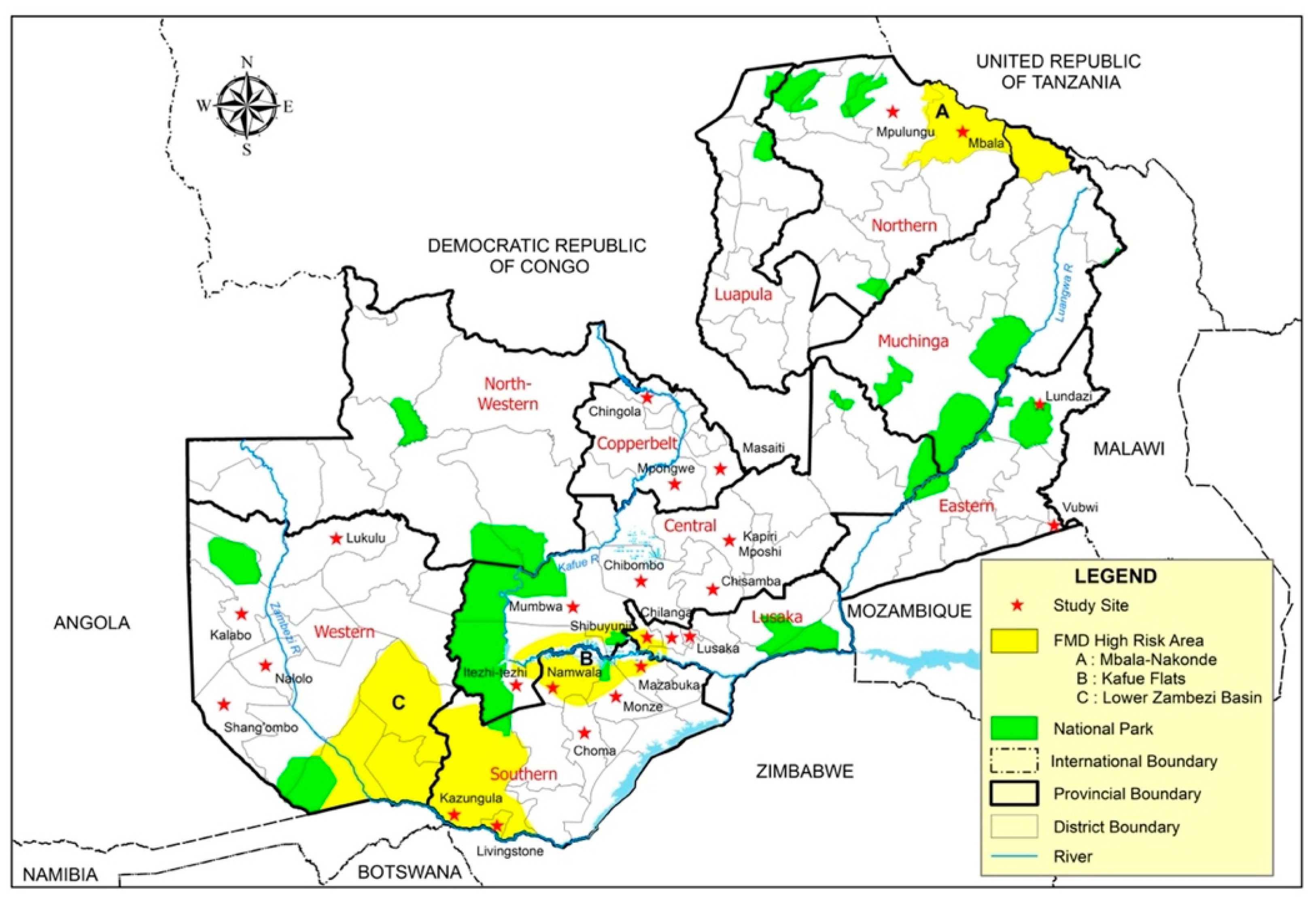
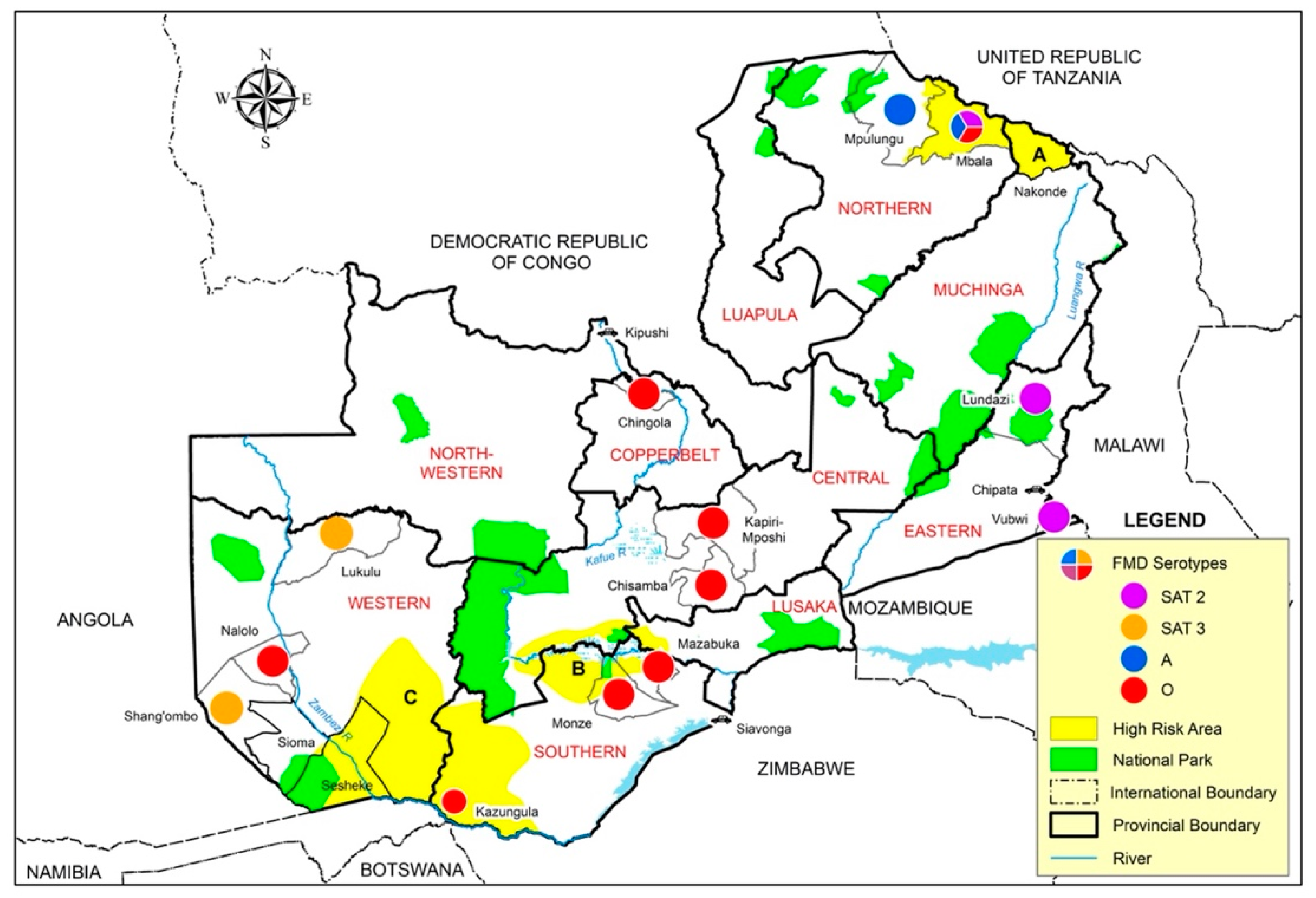
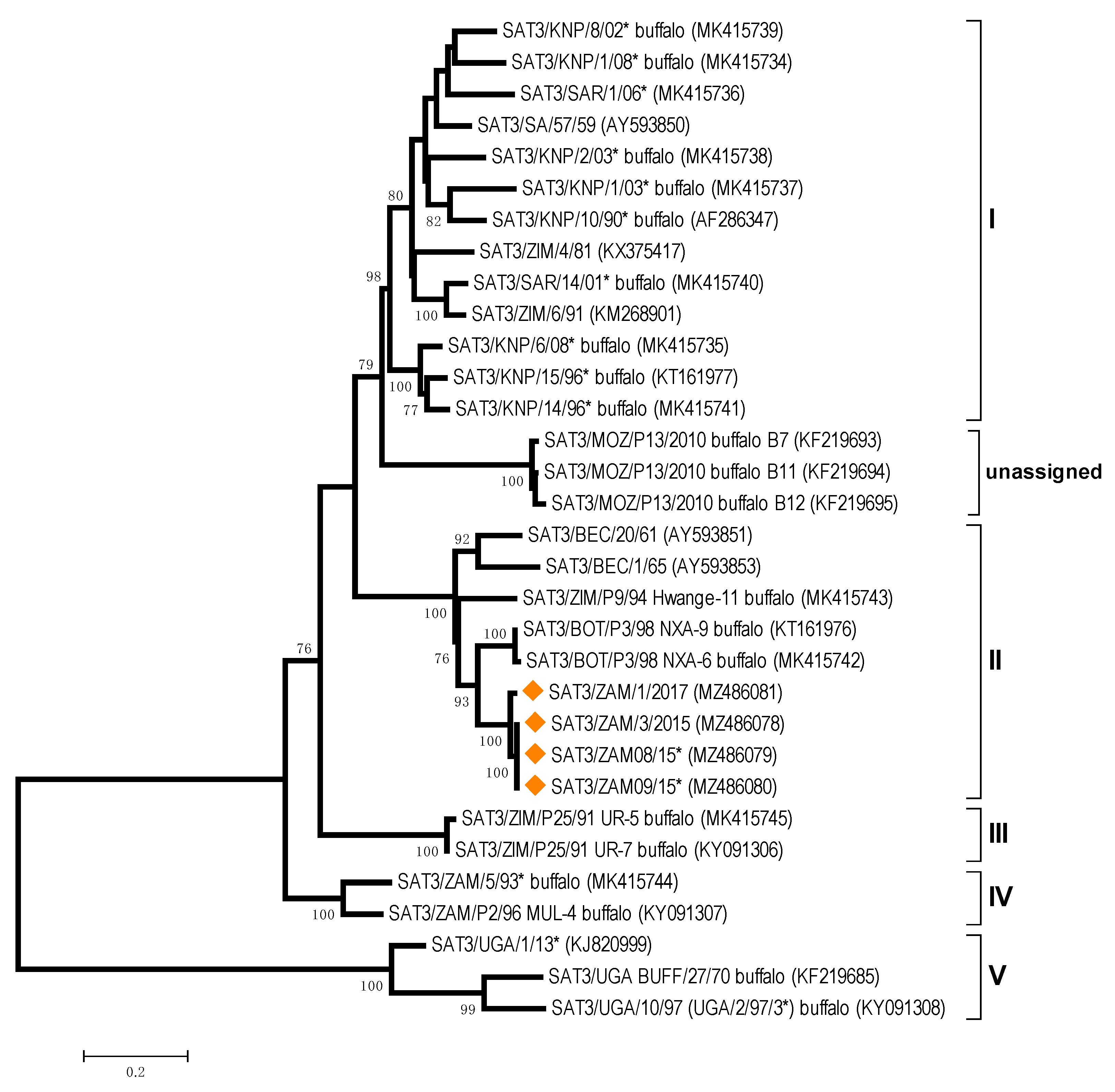
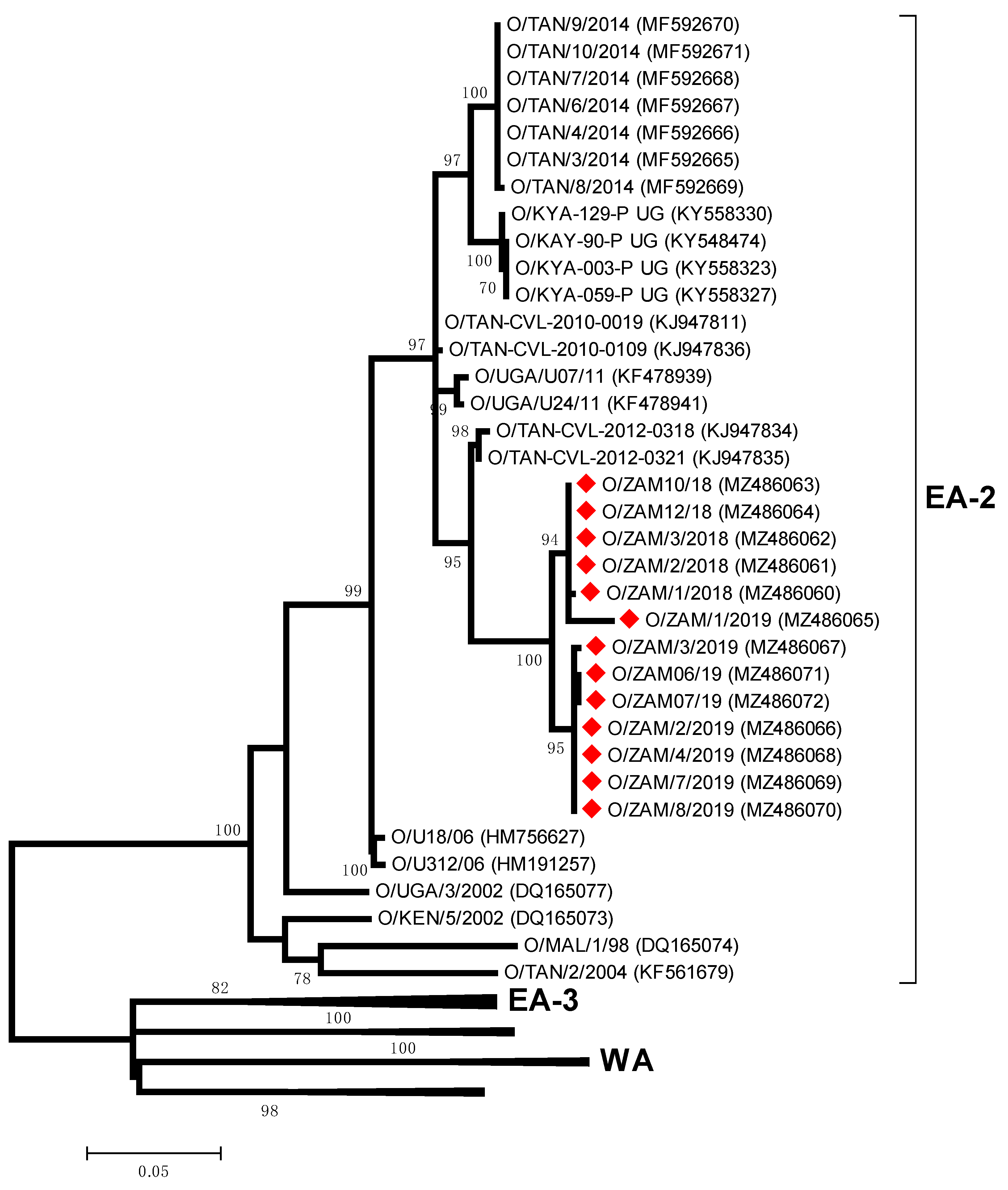
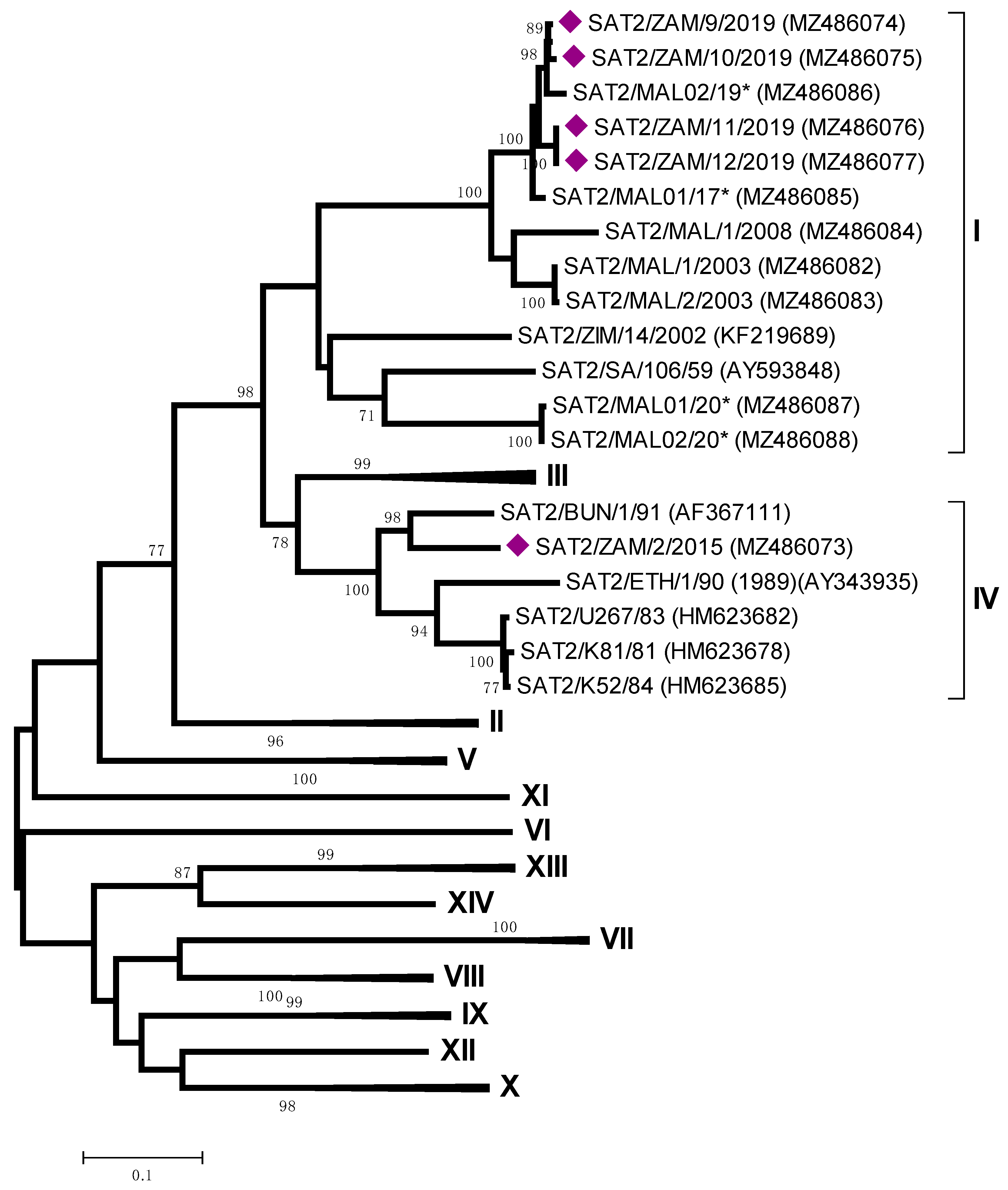
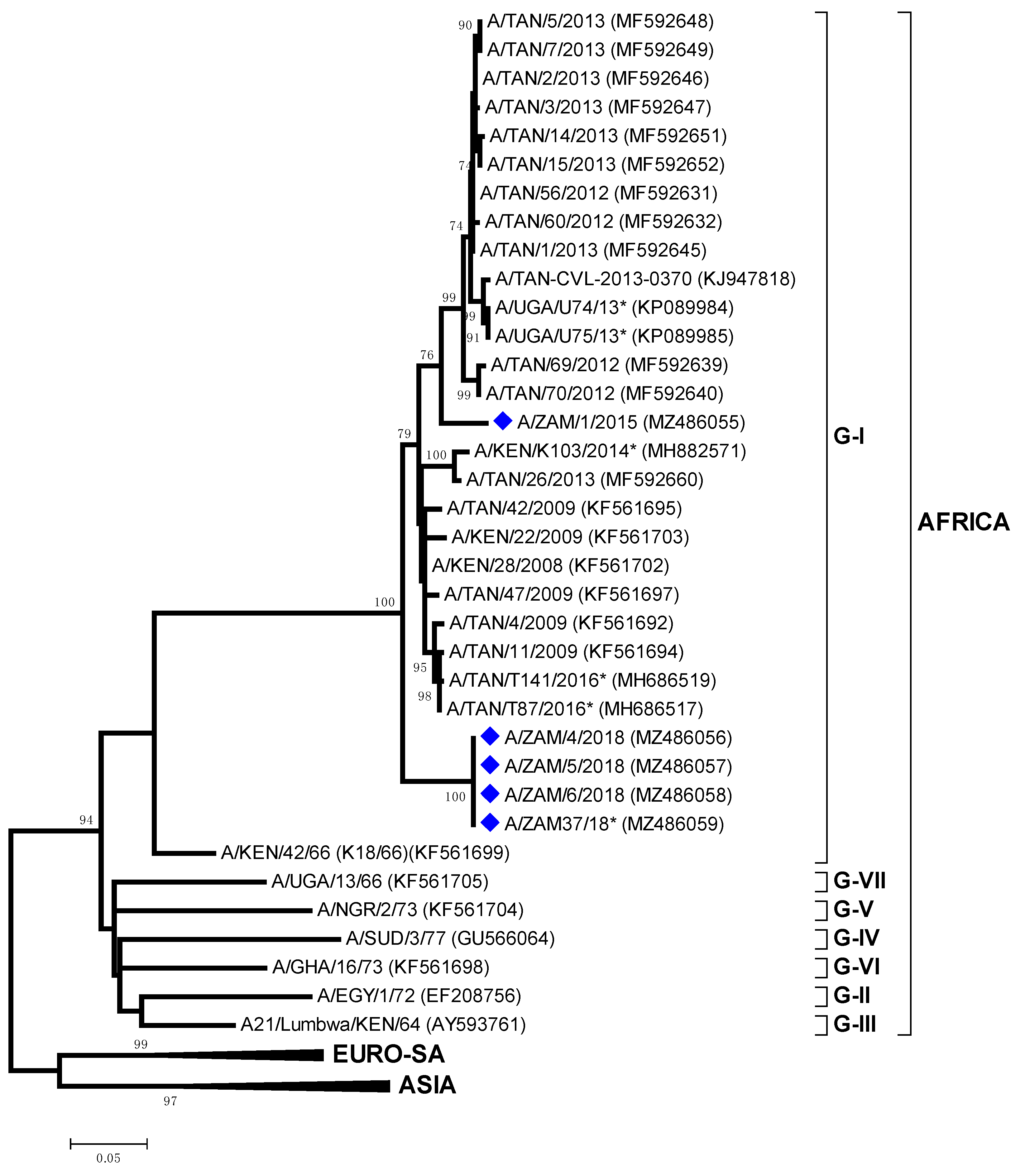
| CVRI Ref No. | Date Collected (DD/MM/YYYY) | Species | Vet Camp/Village | District, Province | NSP | Serotype | WRLFMD Ref. No. | BVI Ref. No. | RT-qPCR | Serotype | Topotype | Lineage |
|---|---|---|---|---|---|---|---|---|---|---|---|---|
| MM01 | 02.4.2015 | Bovine | Mupata Village | Mpulungu, Northern | Positive | ND | ZAM/1/2015 | FMDV-GD | A | AFRICA | G-I | |
| HS 01 | 28.2.2015 | Bovine | Chimula Village | Mbala, Northern | Positive | ND | ZAM/2/2015 | ZAM03/15 | FMDV-GD | SAT 2 | IV | - |
| Sh 01 | 23.10.2015 | Bovine | Shangoomb, Western | Positive | ND | ZAM/3/2015 | ZAM09/15 | FMDV-GD | SAT 3 | II (WZ) | - | |
| LK1 | 18.5.2017 | Bovine | Mbanga & Mulongo | Lukulu, Western | Positive | ND | ZAM/1/2017 | ZAM08/17 | FMDV-GD | SAT 3 | II (WZ) | - |
| K1 | 04.1.2018 | Bovine | Kaluwe & Siluwe | Kalabo, Western | Positive | ND | ||||||
| Chisa 16-380 | 24.3.2018 | Bovine | Chisamba | Chisamba, Central | Negative | ND | ZAM/1/2018 | - | FMDV-GD | O | EA-2 | - |
| Chisa 16-169 | 24.3.2018 | Bovine | Chisamba | Chisamba, Central | Negative | ND | ZAM/2/2018 | - | FMDV-GD | O | EA-2 | - |
| BBR-1 | 24.3.2018 | Bovine | Chisamba | Chisamba, Central | Negative | ND | ZAM/3/2018 | - | FMDV-GD | O | EA-2 | - |
| TS 01 | 24.10.2018 | Bovine | Kawimbe | Mbala, Northern | Positive | ND | ZAM/4/2018 | - | FMDV-GD | A | AFRICA | G-I |
| ES 01 | 24.10.2018 | Kawimbe | Mbala, Northern | Positive | ND | |||||||
| ES 02 | 24.10.2018 | Bovine | Kawimbe | Mbala, Northern | Positive | ND | ZAM/5/2018 | - | FMDV-GD | A | AFRICA | G-I |
| GS 01 | 24.10.2018 | Bovine | Kawimbe | Mbala, Northern | Positive | ND | ZAM/6/2018 | - | FMDV-GD | A | AFRICA | G-I |
| ES03 | 24.10.2018 | Bovine | Kawimbe | Mbala, Northern | Positive | ND | - | ZAM37/18 | FMDV-GD | A | AFRICA | G-I |
| VS 02 | 27.3.2018 | Bovine | Kawimbe | Mbala, Northern | Positive | ND | - | ZAM10/18 | FMDV-GD | O | EA-2 | - |
| VS 05 | 27.3.2018 | Bovine | Kawimbe | Mbala, Northern | Positive | ND | - | ZAM12/18 | FMDV-GD | O | EA-2 | - |
| ZRC 1 | 18.1.2019 | Bovine | Chisamba Central | Chisamba, Central | Positive | ND | ZAM/1/2019 | - | FMDV-GD | O | EA-2 | - |
| CVRI67/19 | 17.7.2019 | Chibombo, Central | Positive | ND | ||||||||
| CVRI04/19 | 11.2.2019 | Bovine | Ufwenuka | Monze, Southern | Positive | O | ZAM/2/2019 | - | FMDV-GD | O | EA-2 | - |
| CVRI01/19 | 11.2.2019 | Bovine | Ufwenuka | Monze, Southern | Positive | O | ZAM/3/2019 | - | FMDV-GD | O | EA-2 | - |
| CVRI08/19 | 11.3.2019 | Bovine | Magoye | Mazabuka, Southern | Positive | O | ZAM/4/2019 | - | FMDV-GD | O | EA-2 | - |
| 17562 | 16.3.2019 | Chibombo, Central | - | ZAM/5/2019 | - | NGD | - | - | - | |||
| 17496 | 17.3.2019 | Chibombo, Central | - | ZAM/6/2019 | - | NGD | - | - | - | |||
| CVRI16/19 | 30.3.2019 | Bovine | Kasako | Mazabuka, Southern | Positive | O | ZAM/7/2019 | - | FMDV-GD | O | EA-2 | - |
| CVRI15/19 | 30.3.2019 | Bovine | Kasako | Mazabuka, Southern | Positive | O | ZAM/8/2019 | - | FMDV-GD | O | EA-2 | - |
| CVRI22/19 | 02.4.2019 | Bovine | Mwase | Lundazi, Eastern | Positive | SAT-2 | ZAM/9/2019 | - | FMDV-GD | SAT 2 | I | - |
| CVRI23/19 | 02.4.2019 | Bovine | Mwase | Lundazi, Eastern | Positive | SAT-2 | ZAM/10/2019 | - | FMDV-GD | SAT 2 | I | - |
| CVRI20/19 | 03.4.2019 | Bovine | Zozwe & Mlawe | Vumbwi, Eastern | Positive | SAT-2 | ZAM/11/2019 | - | FMDV-GD | SAT 2 | I | - |
| CVRI21/19 | 03.4.2019 | Bovine | Mbande | Vumbwi, Eastern | Positive | SAT-2 | ZAM/12/2019 | - | FMDV-GD | SAT 2 | I | - |
| CVRI25/19 | 03.5.2019 | Bovine | Feni | Chipata, Eastern | Positive | SAT-2 | - | - | SAT 2 | |||
| CVRI37/19 | 16.6.2019 | Bovine | Lwashimba | Kapiri Mposhi, Central | Positive | O | - | ZAM06/19 | FMDV-GD | O | EA-2 | - |
| CVRI55/19 | 28.6.2019 | Bovine | Musenga | Chingola, Copperbelt | Positive | O | - | ZAM07/19 | FMDV-GD | O | EA-2 | - |
| CVRI29/19 | 20.5.2019 | Bovine | Chitongo | Namwala, Southern | Positive | O | - | - | O | |||
| CVRI30/19 | 20.5.2019 | Bovine | Chitongo | Namwala, Southern | Positive | O | - | - | O | |||
| CVRI31/19 | 05.6.2019 | Porcine | Hamangaba | Monze, Southern | Positive | O | - | - | O | |||
| CVRI32/19 | 05.6.2019 | Porcine | Hamangaba | Monze, Southern | Positive | O | - | - | O | |||
| CVRI61/19 | 12.6.2019 | Bovine | Sunrise (Kasupe) | Chilanga, Lusaka | Positive | O | - | - | O | |||
| CVRI36/20 | 14.2.2020 | Porcine | Makeni | Chilanga, Lusaka | Positive | O | - | - | O | |||
| CVRI01/20 | 14.1.2020 | Bovine | Kaungaleuti | Nalolo, Western | Positive | O | - | ZAM03/20 | FMDV-GD | O | EA-2 | - |
| CVRI02/20 | 14.1.2020 | Bovine | Kaungaleuti | Nalolo, Western | Positive | O | - | - | O | |||
| CVRI05/20 | 14.1.2020 | Bovine | Kaungaleuti | Nalolo, Western | Positive | O | - | - | O | |||
| CVRI06/20 | 14.1.2020 | Bovine | Kaungaleuti | Nalolo, Western | Positive | O | - | - | O | |||
| CVRI13/20 | 17.4.2020 | Bovine | Luubwe | Itezhi- Tezhi, Central | Positive | O | - | - | O | |||
| CVRI14/20 | 17.4.2020 | Bovine | Luubwe | Itezhi- Tezhi, Central | Positive | O | - | - | O | |||
| CVRI17/20 | 17.4.2020 | Bovine | Luubwe | Itezhi- Tezhi, Central | Positive | O | - | - | O | |||
| CVRI15/20 | 17.4.2021 | Bovine | Luubwe | Itezhi- Tezhi, Central | Positive | O | - | - | O | |||
| CVRI29/20 | 13.8.2020 | Bovine | Makeni | Chilanga, Lusaka | Positive | O | - | - | O | |||
| CVRI25/20 | 10.3.2020 | Bovine | Nyawa | Kazungula, Southern | Positive | O | - | - | O |
Publisher’s Note: MDPI stays neutral with regard to jurisdictional claims in published maps and institutional affiliations. |
© 2021 by the authors. Licensee MDPI, Basel, Switzerland. This article is an open access article distributed under the terms and conditions of the Creative Commons Attribution (CC BY) license (https://creativecommons.org/licenses/by/4.0/).
Share and Cite
Banda, F.; Sinkala, Y.; Mataa, L.; Lebea, P.; Sikombe, T.; Kangwa, H.L.; Fana, E.M.; Mokopasetso, M.; Wadsworth, J.; Knowles, N.J.; et al. Characterization of Foot-and-Mouth Disease Viruses in Zambia-Implications for the Epidemiology of the Disease in Southern Africa. Viruses 2021, 13, 2195. https://doi.org/10.3390/v13112195
Banda F, Sinkala Y, Mataa L, Lebea P, Sikombe T, Kangwa HL, Fana EM, Mokopasetso M, Wadsworth J, Knowles NJ, et al. Characterization of Foot-and-Mouth Disease Viruses in Zambia-Implications for the Epidemiology of the Disease in Southern Africa. Viruses. 2021; 13(11):2195. https://doi.org/10.3390/v13112195
Chicago/Turabian StyleBanda, Frank, Yona Sinkala, Liywalli Mataa, Phiyani Lebea, Tingiya Sikombe, Henry L. Kangwa, Elliot M. Fana, Mokganedi Mokopasetso, Jemma Wadsworth, Nick J. Knowles, and et al. 2021. "Characterization of Foot-and-Mouth Disease Viruses in Zambia-Implications for the Epidemiology of the Disease in Southern Africa" Viruses 13, no. 11: 2195. https://doi.org/10.3390/v13112195
APA StyleBanda, F., Sinkala, Y., Mataa, L., Lebea, P., Sikombe, T., Kangwa, H. L., Fana, E. M., Mokopasetso, M., Wadsworth, J., Knowles, N. J., King, D. P., & Quan, M. (2021). Characterization of Foot-and-Mouth Disease Viruses in Zambia-Implications for the Epidemiology of the Disease in Southern Africa. Viruses, 13(11), 2195. https://doi.org/10.3390/v13112195







